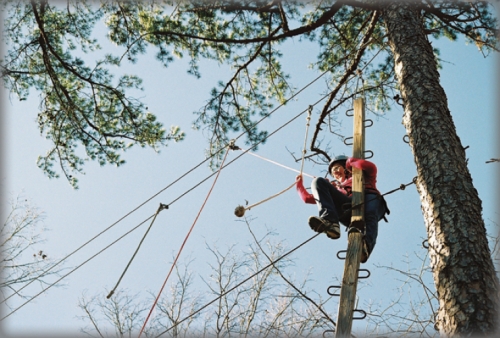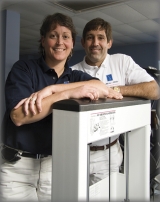I’m dying,” the breast cancer patient told Claudio Battaglini. “I’m not going to make it. I have no energy. I can’t sleep. I have no hope.”
“Let us help,” Battaglini told her.
Less than a week later she was back. “You saved my life,” she said.

Sandy, a breast-cancer patient, uses a ropes course to boost her fitness and confidence, improving her response to treatment. Photo by Cary Jones, ©2007 Endeavors.

Click to read photo caption.
What had Battaglini and his research partner Diane Groff done for this woman? They hadn’t cured her cancer. In fact, they hadn’t treated her cancer at all. Instead, they had given her a program of exercise and recreational therapies to regain physical fitness, reduce stress, and help her cope.
“When a person is diagnosed with cancer, it’s a tremendous psychological shock, and they lose their self-esteem,” Battaglini says. On top of that, patients are usually immediately thrust into a range of treatments including chemotherapy, radiation, and surgery. The side effects of these treatments — nausea, anemia, and a weakened immune system — can be alleviated with drugs. But having to deal with these symptoms and the impact of cancer on your life and family is stressful. It’s a physical and mental onslaught, one for which most of us are ill-prepared to deal, he says.
Helping patients cope
When Battaglini came to UNC three years ago, he knew that exercise was great for helping people with depression and that it helped people who had lost some physical function after cancer treatment. He wanted to start up an exercise study for cancer patients. He met Groff, a recreational therapist, who was using a variety of techniques to help people work on their emotional well-being. First they struck up a friendship, then a research study.
Battaglini speculated that meeting trainers and other patients might help the patients psychologically. So he and Groff decided to include recreational therapy techniques in the study to measure psychological and physiological outcomes.

Jason Smith
Diane Groff and Claudio Battaglini have found that exercise helps patients psychologically as well as physically. “Cancer is tough on the body and the mind,” Battaglini says. Photo by Jason Smith, ©2007 Endeavors magazine.

Click to read photo caption. Jason Smith
Gretchen was the first patient to enroll. She’d had chemotherapy, radiation, and surgery for her breast cancer a few months before, and had heard that exercise helps prevent breast cancer recurrence. “But you couldn’t have gotten me to a gym when my hair had fallen out,” Gretchen admits. The wig was too hot, and the hat just wasn’t her. Mostly, though, she didn’t want to talk to complete strangers about her cancer. Battaglini and Groff’s program was perfect for her because the gym was reserved for breast cancer patients — it was completely private.
“Each patient has an individualized plan with a combination of cardiovascular workout and strength training,” Battaglini explains. During the program the researchers monitor heart function, muscular strength, and flexibility.
Gretchen, who says she was never much of an exerciser before, has been in the program for four months. “I feel better now than I did before I was diagnosed with cancer,” she says. One of the drugs she takes to treat her breast cancer, herceptin, can be toxic to the heart. But since enrolling in the study, Gretchen’s tests have shown that her heart is doing better than ever.
Recreational therapy
Battaglini and Groff also help patients learn how to cope with stress. Mimi, another patient, uses an emWave monitor to help increase her heart rate coherence and variability. The monitor displays color-coded information about her heart rate. “When the indicator is green, it’s much better for your heart rhythm,” she says. “You are calm and relaxed and happy.”
Groff uses biofeedback games to help achieve this state. In one game called “The Journey to the Wild Divine,” she uses a computer to display the patient’s heart rate and sweat gland activity as a floating balloon. As the patient’s heart rate increases, the balloon rises, and as her heart rate lowers, so does the balloon. Popping the balloon means the patient’s heart rate was off the chart. “You get the balloon lower by getting into a deep state of relaxation,” Groff says. Simple deep-breathing techniques help, but it’s also about getting deep appreciation, happiness, and joy to replace anxiety, anger, apathy, and frustration. “These games don’t just teach relaxation, they teach how to stay in these positive states,” she says.
The biology behind this is simple, Groff says. “Anxiety promotes the release of cortisol, and cortisol can lead to hypertension, diabetes, and heart disease — all that bad stuff.” But according to Groff, these exercises can help control your physiological response to anxiety.
For Gretchen, the stress reduction came relatively easily; as a musician, she dealt with performance stress. “I needed to get into a good place quickly,” she says, and now the biofeedback exercises help her do just that in all aspects of her life. Now, she says, she stops and breathes when things get tough.
Another technique that Groff teaches is “mindful leisure” — taking a leisure activity you enjoy and getting into it so much that you can block out distracting thoughts. Mimi has taken up journaling, something she’d done before but is now really getting back into. Gretchen had always wanted to do beading, so she and Groff make and bake tiny clay beads.
Skepticism
But it hasn’t been easy to persuade doctors that this approach will work.
“Exercise is not a new concept for helping cancer patients,” Battaglini explains. Scientists have been investigating exercise and cancer for more than twenty years. “Exercise has been shown to be an amazing complementary therapy,” he says. “We see this in the literature; there is empirical evidence showing the benefits.” So why are doctors still skeptical?
“Physicians look for clinical randomized trials to believe that an intervention is beneficial and safe for their patients,” Battaglini says. “They can’t just try an intervention and see if it works.”
And exercise research doesn’t easily lend itself to a randomized, clinical trial. It’s difficult to enroll enough patients in a study, and without sufficient numbers the results are weak. Also, they have yet to determine the frequency, intensity, and most appropriate types of exercise. And the big problem — no one really knows why exercise has been so good.

Jason Smith
Mimi uses biofeedback to improve her heart function.

Click to read photo caption. Jason Smith
But Groff and Battaglini say it’s clear that their patients — who report feeling great within just a few weeks — love the program. The researchers want to do more than just get their patients through the next few months of symptoms, though. “I truly believe that cancer is tough on the body and the mind, and the things we are trying to teach here will make an overall difference to their lives as a whole,” Battaglini says.
Gretchen and Mimi have already seen the difference. Mimi, who says she was just skin and bones after losing thirty pounds during chemotherapy, is going skiing next week. “It’s all about your attitude,” she says.






